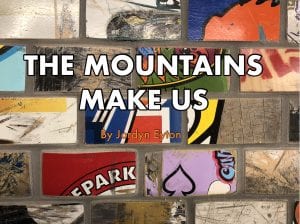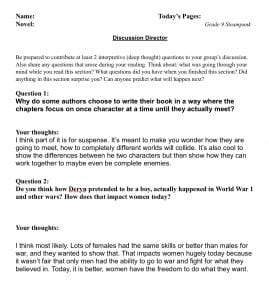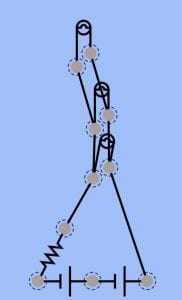I actually have no idea how to start this post. I’m running out of ways!! Sometimes I start them in a different language, sometimes I pretend I didn’t know you guys were there, and sometimes I just start by saying “Hi!” Here’s a question, what is your favourite way for me to start a post, let me know down below in the comments.
It’s been a while since I did a REAL humanities post. I mean there was the one about steampunk (How Can I Steampunk My Life) and then the last big one I did was “The Mountains Make Us” which was a post all about Identity.
This post is all about a crazy project we have been working for probably the past two months called……. METAPHOR MACHINES!! Metaphor Machines are where science and humanities meet to create these amazing Rube Goldberg are chain reaction contraptions. It kind of reminds me of the project we did last year in grade 8 when we brought New France and Shakespeare together to make a play. But this time, we actually brought three different components, at least, in to the final product of Metaphor Machines. We needed the skills to build a machine accurately, the knowledge of one of the significant revolutions, how to make circuits work, and how to turn all of that into a metaphorically correct mechanical machine. As a result of all of this is, of course, our driving question, “How do ideas drive change?” I will explain these different components in more depth through out the post, but I think that’s my queue to get going!
WHAT WAS THE TASK?
I am starting with what I would usually do at the end of the post, I’ll show you the finished product of the project and then talk about all of the work that went into it. This unit’s task was to turn a revolution, in our case The Haitian Revolution, into a metaphor whilst building a machine with at least one working circuits. Once this was all complete which took several tries, (When I several I mean like 10 billion) we had yet another ingredient to add into the mix. If you recall, I just finished a post on video skills, it’s the Live Event one. Those skills we learned were incorporated into the final video that talked about everything we learned, it was like the final test, though in PLP, we don’t do tests. This video went through a critique session so that we would have a close to perfect final copy.
That right there was allllllllllll of the feedback we received from everyone in our class on our first draft. Of course we tried to take all of it but some of it didn’t quite make sense so we just fixed the major things that we kept seeing and took turns editing it between our group, my group included me of course, Taylor, Fraser, and Caleb. After all of the editing we came out with this beauty which I will showcase down below for you guys to see, hope you enjoy our metaphor machine video for the Haitian Revolution.
STEAMPUNK WAS IMPORTANT BUT NOT THAT IMPORTANT
If you remember, a few weeks ago I did a post about a genre/aesthetic called steampunk. That was one of the things we studied through out the whole unit but it wasn’t SUPER important compared to other parts, it is something our project could have done without. But, saying that, it definitely makes it much much more interesting and fun to look at our machines if they have a theme.
We also studied a book called the Leviathan which is a prominently steampunk genre of book because of the time it is set in. It was a actually a very good book and I definitely recommend reading it not only cause it teaches you about the past, but because steampunk is an upcoming obsession for people around the world and it is very nice to know about it.
Here is some of the work we did on it, our novel study:
THE HAITIAN REVOLUTION
So as you have probably heard a few times through out this post, we were studying the Haitian Revolution. It was actually a really interesting revolution and resulted in some pretty amazing, well, I don’t know if that’s thre right word, impactful…. impacts? Yeah that’s not really what I meant to say but you get the idea. Instead of just writing a timeline for you guys, here is a quick video made by Crash Course that explains the whole thing in an actually interesting way!
SCIMATICS SIDE OF THINGS
I have been talking about our humanities side of the project almost the whole time so far, we can’t forget the importance of science and math in this project. Let’s start with circuits. We had been working on circuits since the beginning of the school year so we knew them pretty well. We knew that there were two types, parallel and series. Here are images of the 2 different kinds:
- Parallel Circuit
- Series Circuit
I used an awesome website that has a circuit simulator and we used it a lot through out the unit, it really helped me learn about them. Having one of each was one of the requirements of the machine so of course, we included them. The light that you saw at the beginning was a parallel circuit and it’s circuit diagram looked like this:
Oh by the way, here is a legend for the different symbols of a circuit:
Then you see closer to the end of the machine, we have a car. This is a series circuit. Now, they don’t have a motor symbol on that website so I will just use a light but this is what it looked like:
Another really important part of our machine was learning about blueprints and scale. Scale is something that can be used in many different jobs. Carpentry and Architecture are just a couple examples where it is used to draw for example, a house, smaller on a piece of paper than it would be in real life because that we be a pretty giant piece of paper! We used it to plan out are machine in three different steps. First was our individual sketch:
This used barely any scale whatsoever, it was just to decide what the elements would be. Next came the group sketch. This is when we finalized the components and combined our ideas. It is also more to scale than the last, the scale being 5cm to 1 cube or 1cm.
Last step was….. THE FINAL FULL SIZE BLUEPRINT!! We all worked on this one together but this one was a bit different. It wasn’t to scale, it wasn’t random, these had to be the literal, real measurements of what the things on our machine would be. And…. here it is!
These 2 elements, blueprints/scale and circuits are very important not just for the success of this project, but in everyday life. Circuits are things that are all around us, there are millions of circuits in just our smartphones and blueprints are extremely important as well. Our houses, buildings, parks and more wouldn’t be, they literally would not exist if it wasn’t for blueprints and planning.
HOW DO IDEAS DRIVE CHANGE?
Ideas. Are. Everything. An idea is where everything starts, it’s the spark that starts the blazing fire. (Haha get it, I just used a metaphor!!) In our case the slaves got one small idea that they would be freed from half way across the world and that is all it took. That is all it took to start a 13 year revolution and free slaves along with create a whole new country, the country of Haiti. It takes passion and drive to do what you want, you need to want to fulfill dreams. There were many other revolutions in history all starting with one persons idea and that is how they all folded out and how people made what they want happened. Ok guys, thanks for pulling through and have a great day!
~Jordyn




















Leave a Reply